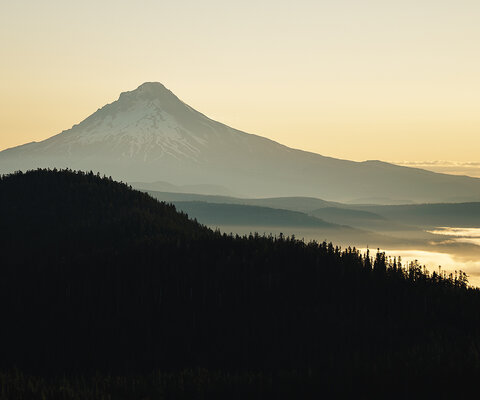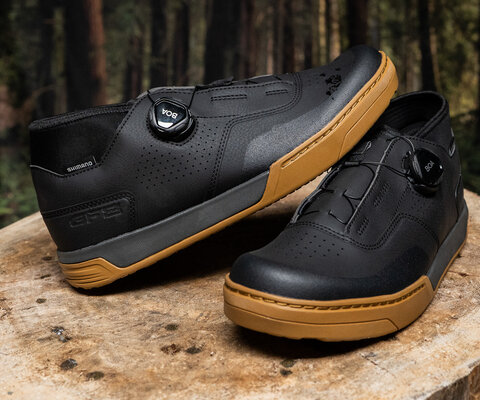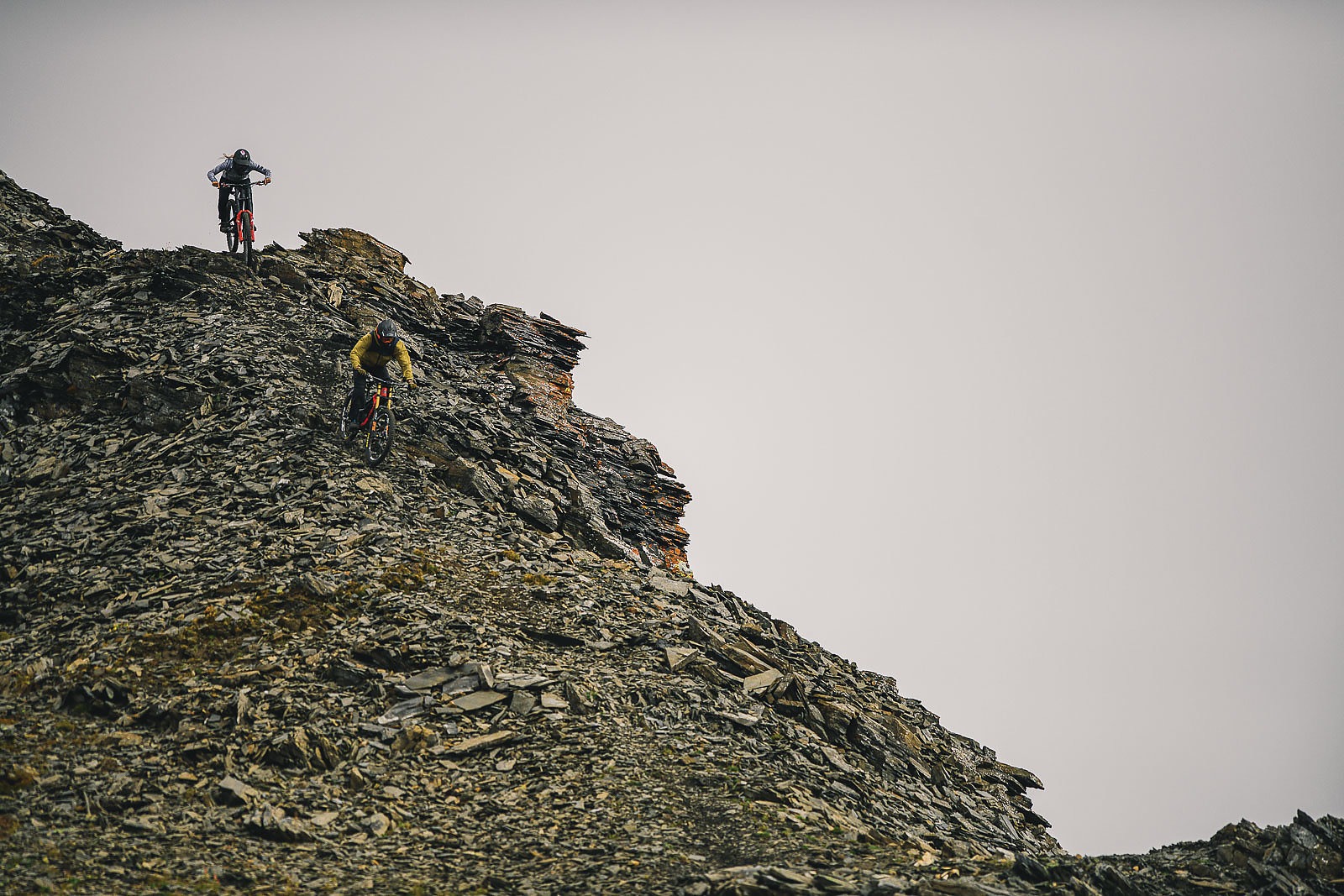
Divine Elements Leaving a Legacy in Antoine Basin
Words by Jann Eberharter | Photos by Paris Gore
The universe has 94 known naturally occurring elements.
Hydrogen and helium, the two most common, are understood to have formed during the Big Bang some 13.8 billion years ago, while numbers six (carbon) through 26 (iron) have been formed through stellar nucleosynthesis, or nuclear fusion within stars. Elements 27 (cobalt) and beyond are formed by supernova nucleosynthesis—essentially, exploding stars.
These little bits of supernova explosions, which include the majority of heavy metals, exist throughout Earth and are the main reason so many peaks and ridgelines of British Columbia’s Kootenay mountains are accessible today. In Antoine Basin, just a few miles northwest of the small ghost town of Sandon, the existence of argentiferous galena—a sulfur, lead and silver ore (the latter two elements formed by supernovas)—brought miners to these mountains as early as the late 1800s.
More than a century ago, this area was in the midst of an economic boom. In the late 1890s, Sandon had a population of 5,000 (with 23 saloons) and would go on to produce more than a billion dollars worth of silver, lead and zinc in its heyday. Just about every hillside still has a road cut across its face, and back then the only things bigger than the miners’ egos were the tailing piles they left behind.
If it weren’t for such incredibly destructive mining practices—often, entire forests would be burned to the ground to speed up the clear-cutting process—there’s a good chance this entire region would be considerably wilder. Decades of natural recovery have already taken place, but the reality is that these peaks and valleys will never return to their original state. Another reality is that without its evil history, this land would have far fewer mountain bike trails on its slopes.
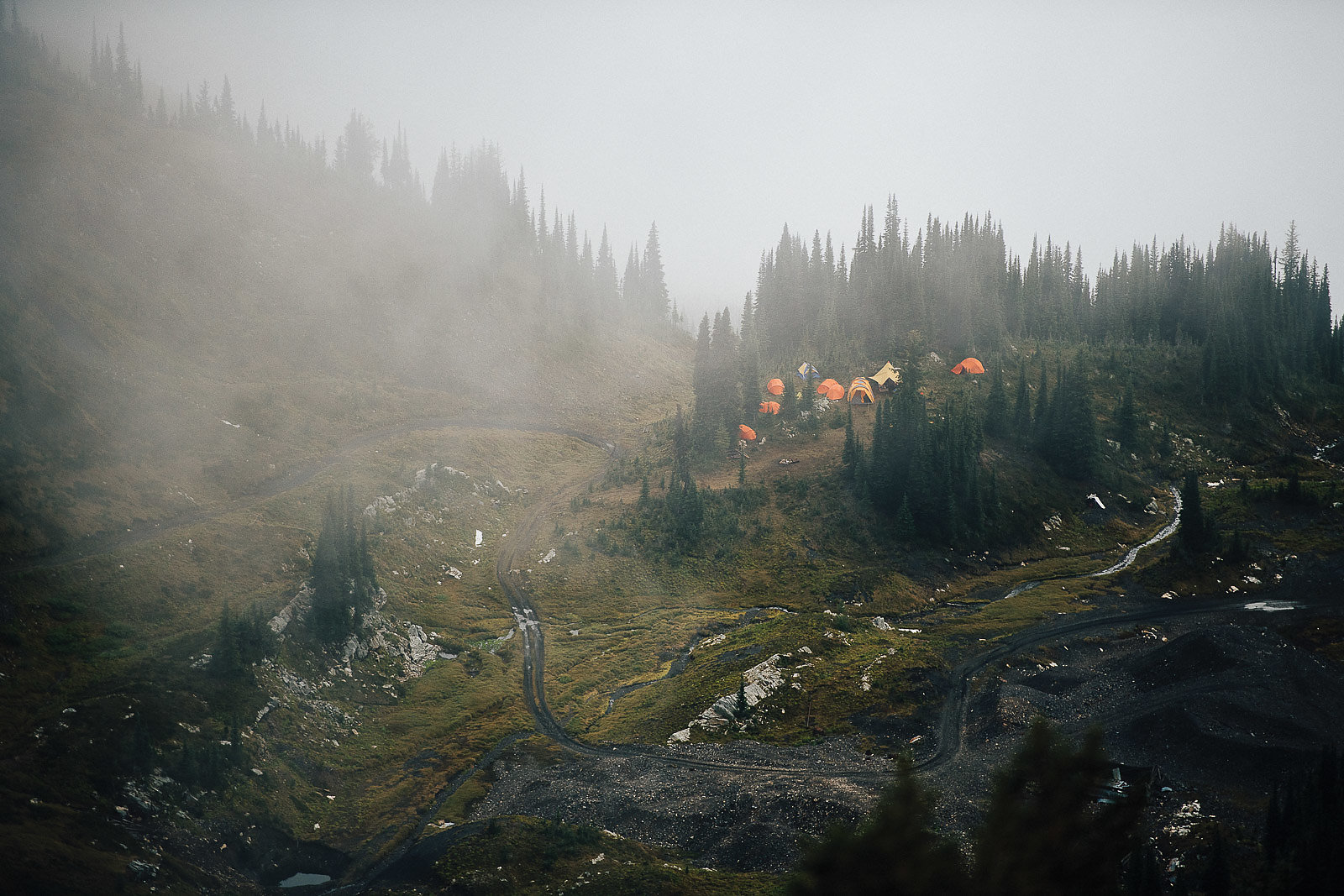
Fast forward to today and freeride legend Thomas Vanderham and prodigy Veronique Sandler are standing at the top of Antoine, just one ridge away from Retallack Lodge’s Reco Peak, looking down on a new trail. The shale-covered ridge descends into the foggy abyss below, forming a narrow ribbon of singletrack that was shaped with much less effort than the mines inside this very hill. After the trail drops off the ridge, it cuts into the hillside, twisting and turning its way to the bottom of the basin.
Most of this trail was put in this past summer by the Retallack build crew, led by Rylan Bokstrom, who also works as one of the lodge’s main guides. With 14 days on the ground, the work they’ve already done is impressive. Metamorphic sandstone and shale comprise most of the region’s geology, meaning digging here is easy—until it isn’t. On much of the mountain, flaky bedrock lingers just below the surface. A majority of the bench-cut section the team built is made up of granular shale that stains the hands dark gray, while sporadic chunks of granite offer opportunities for unique features lower down.
“When it comes to creating a new trail, line choice is of the utmost importance to the rider’s experience,” Vanderham says. “These guys have always done a great job of that, and this one was no different. They picked a really nice line down the mountain.”
While much of the work is completed, Vanderham and Sandler aren’t here to simply ride. The idea behind this weeklong backcountry extravaganza is for them to contribute to the cause, helping to refine the line and add some features of their own. In order to make the most of the time spent in the alpine, the whole team—Vanderham and Sandler, along with Rylan and his younger brother Atli—is camping at the bottom of the basin.
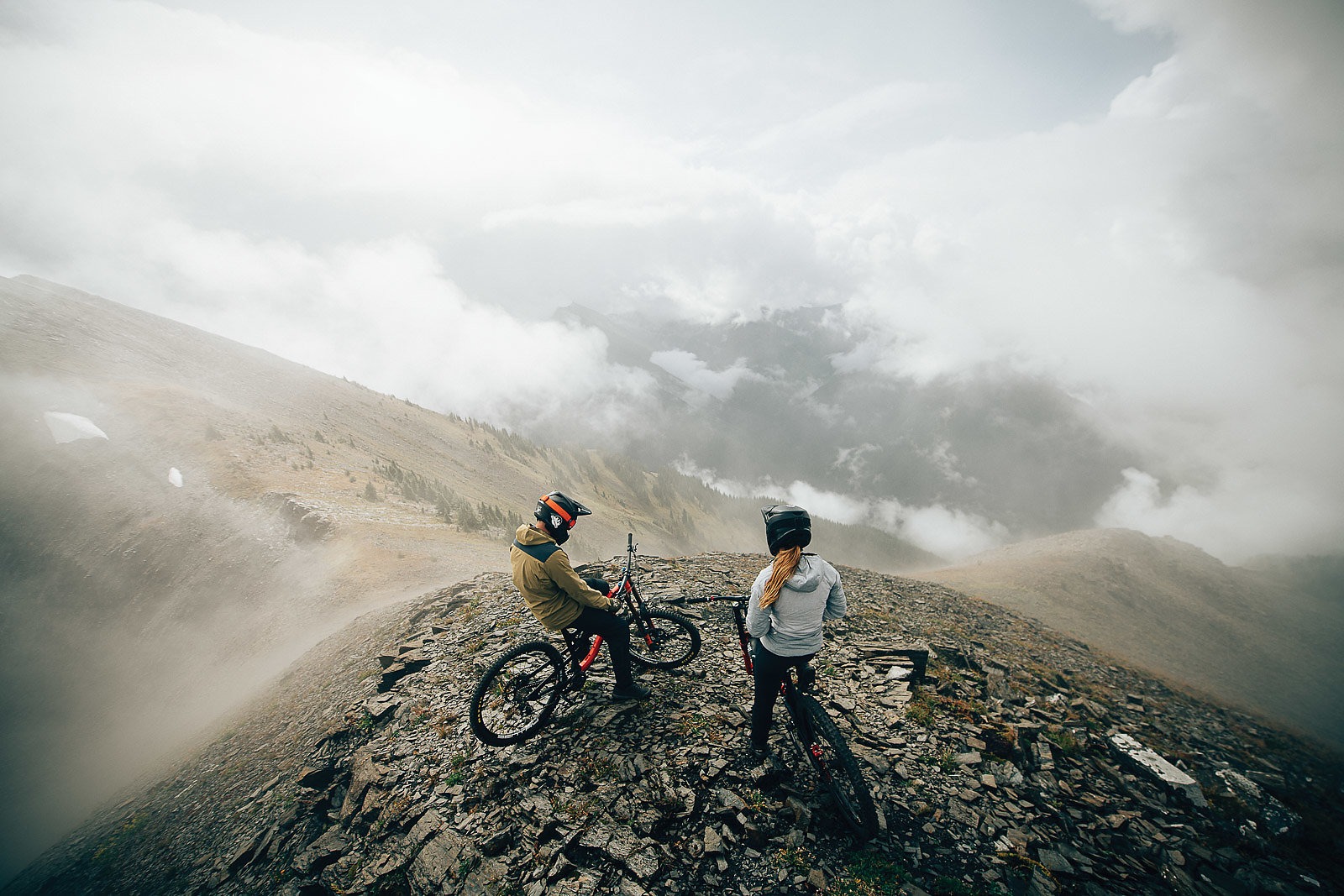
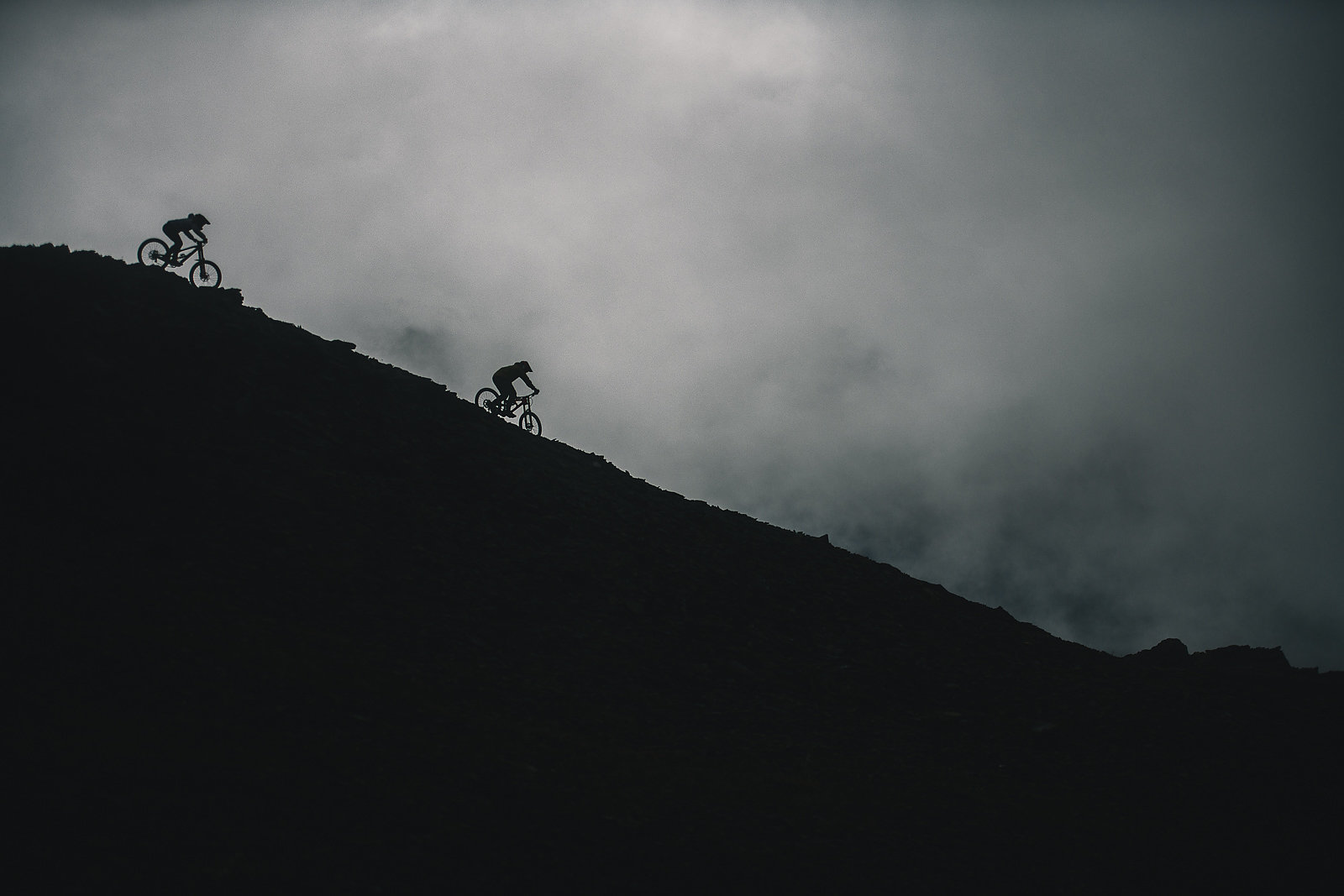
Camp is a small sprawl of tents and canopies. An electric bear fence surrounds the kitchen, as there’s a family of grizzlies in the area. The fire is continuously rolling, although for most of the day it pumps out more smoke than heat. The afternoon everyone arrives, the crew takes a walk up the trail, with the Bokstrom brothers pointing out a number of possible features they’ve been scoping. The hike is cut just short of the summit as ominous dark clouds begin to roll in and thunder echoes in the distance.
“I’ve never been anywhere like [this],” Sandler says. “It’s mad. It makes you feel really small and insignificant.”
“I’ve never been anywhere like this. It’s mad. It makes you feel really small and insignificant.”—Veronique Sandler
Back in the valley, looking up at 270 degrees of ridgeline some 1,000 feet above, it’s apparent this is true backcountry terrain. Sandon—or rather, its remnants—is two hours away by a road requiring a four-wheel-drive vehicle. Retallack Lodge is at least 30 minutes away, via a road only accessible by dirt bikes and quads. The nearest town with appreciable amenities is Nelson, which is 35 miles away as the crow flies, and three and a half hours by road. If an accident were to happen in Antoine, the only real rescue scenario is by helicopter—which has plenty of limitations in its own right.
As guides of the operation, the brothers Bokstrom are constantly vigilant. They check in with the lodge every couple of hours to let them know the team is in good shape. They’re always tossing another log on the fire and formulating ever-changing plans—the days in Antoine, despite whatever the team might have in mind, are dictated by weather.
“The weather moves in fast, it hits hard, and it comes up the valley and then it’s just in the bowl before you even know it’s coming,” Rylan says. “So, it’s really tricky. It’s very hard to predict, is one thing. You can look at all these fancy forecasts and then just chuck it all out the window, because Mother Nature does whatever it wants up here.”
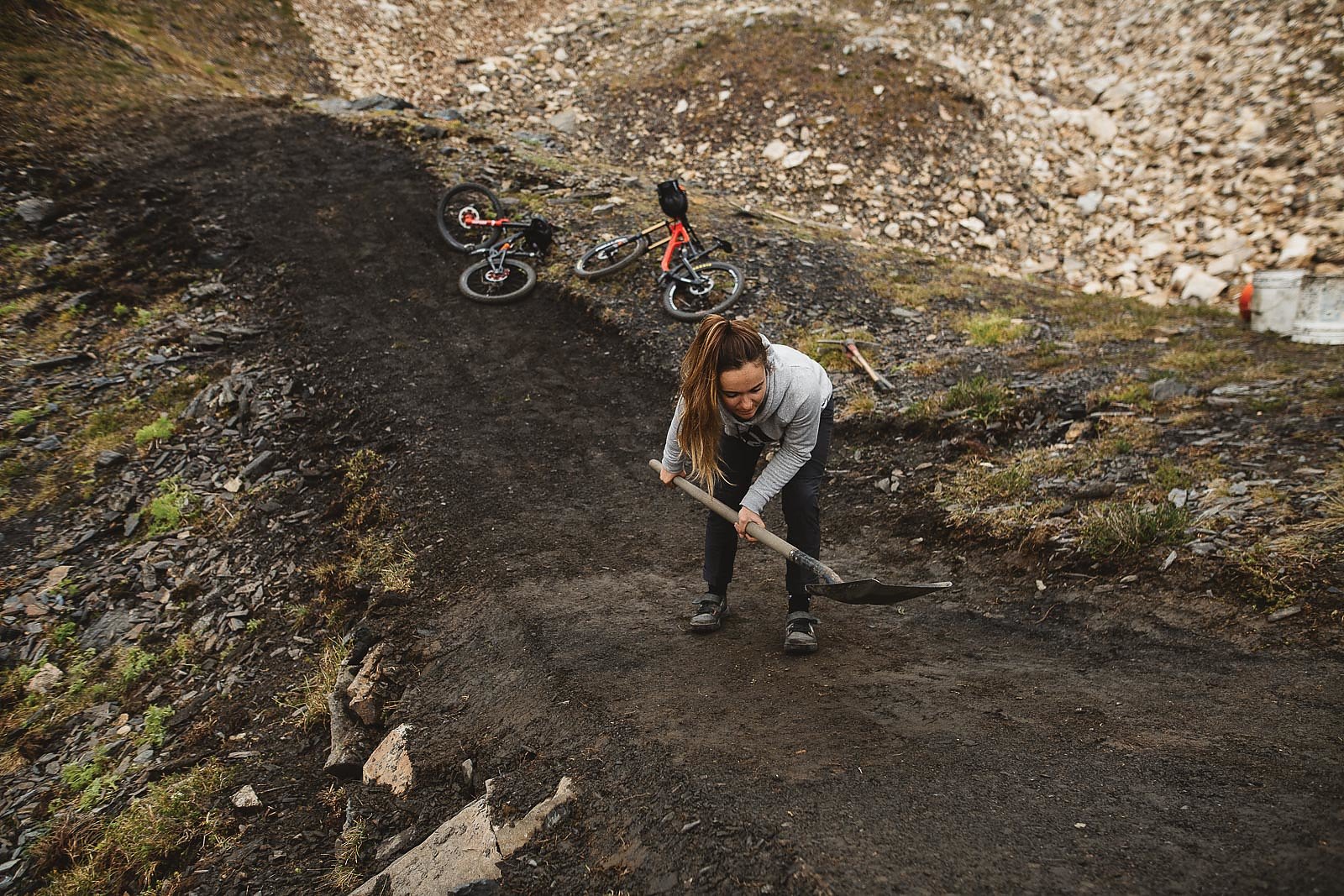
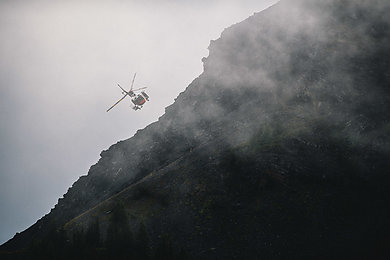
Apparently, what Mother Nature wants to do is unleash the heavens—two inches of rainfall in the first two days, soaking everything in sight. Time is killed with multiple cups of coffee, games of cribbage and stories of less rainy adventures.
Between—and during—the squalls, groundwork begins on a hip feature Vanderham had eyed up during the previous day’s scouting mission. He and Atli break ground on the landing, setting aside slabs of sod, removing rocks and raking dirt. Sandler and Rylan stack rocks where the lip will be, carrying 50-plus-pound boulders from a nearby scree field. Leviathan-sized rocks are pried from the run-in and dozens of buckets of granular scree hauled to the takeoff.
As with the valley’s inhabitants who came before them, it is a quest for elements—but this time of the divine kind. Vanderham and Sandler are looking for speed, loft and flow, components integral to every advanced trail. As the hip begins to take shape, Vanderham repeatedly analyzes how the jump’s trajectory will match the landing and adjusts accordingly.
“There were some question marks kind of based on how it would ride and how much speed the run-in would produce,” Atli says. “The important part is just building them right. Thomas obviously has huge amounts of experience with large jumps, so getting his input was really important. We spent a lot of good time looking at it and engineering it.”
Hitting the hip, though, will have to wait. With so much rain, every part of the jump needs to dry out. After two days of not riding, both Vanderham and Sandler are a little antsy to hop on their bikes. The weather looks to be improving though, so the wait isn’t long.
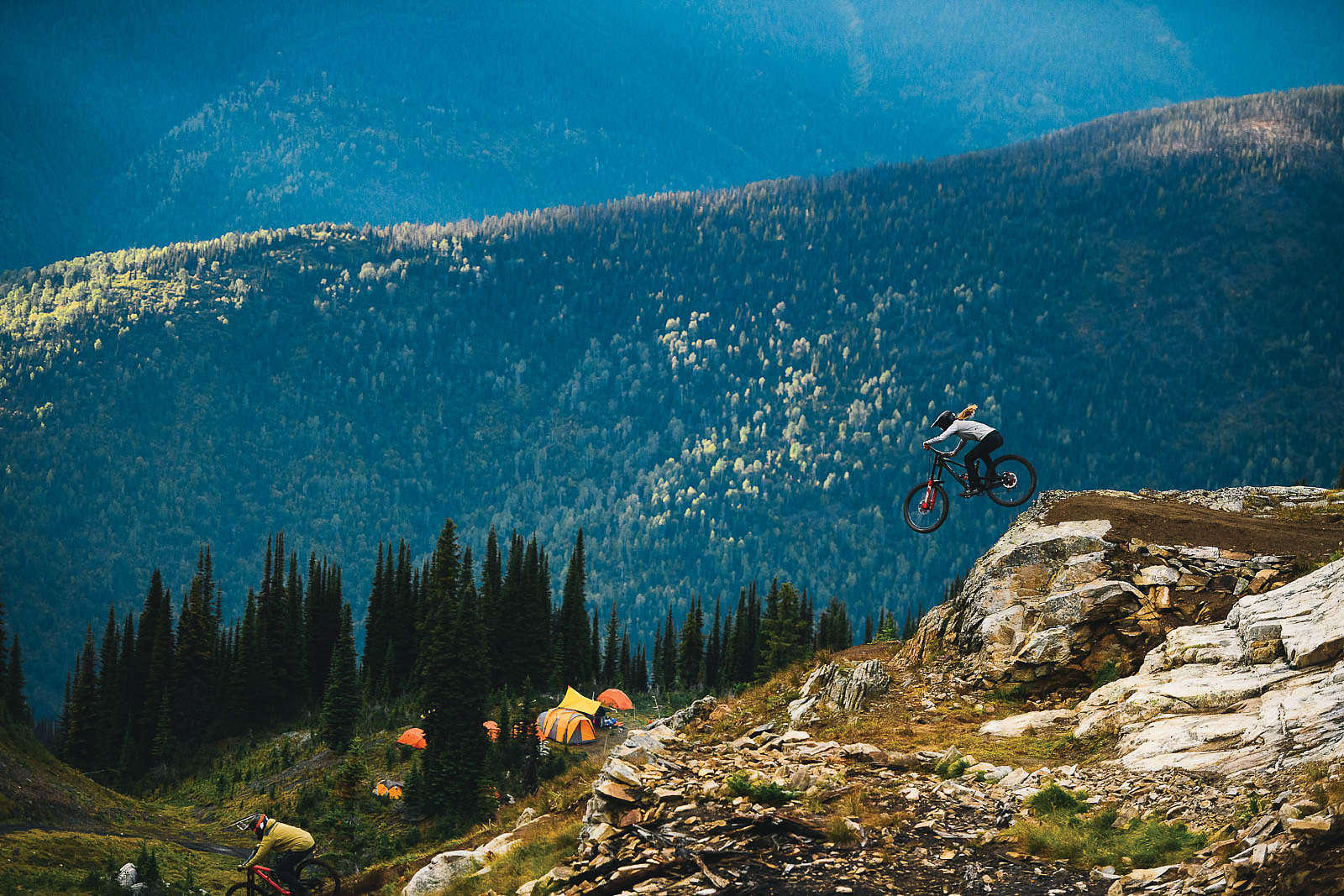
Day three begins with warm rays of light, rather than cold drops of rain. During the time so far in Antoine Basin, the sun has been an agonizing flirt. Now, the morning mist rises off the ridges above, leaving everyone to scarf down their breakfasts, as there’s no knowing how long this spell of clear weather will last.
Today’s journey to the top will be as thrilling as the way down for Vanderham and Sandler, thanks to some forethought from the Bokstroms. The bird can be heard before it’s seen, a faint whooping sound echoing throughout the valley. Whoop, whoop, whoop, whoop. As it descends toward camp, gale-force winds emanate from its rotors. Vanderham and Sandler are all smiles as they hop in. Not many people get to enjoy a helicoptered morning commute to the top of a mountain.
Getting to know a new trail takes time, and it doesn’t come without its challenges. For Sandler, the learning experience comes from the shale. It’s loose, slippery and precariously perched on a knife-edge ridge. A miscalculation would be costly, but within a few minutes she’s riding the section at full speed.
“I was super impressed with the confidence she rode with,” Vanderham says. “She definitely has her own flair to her riding, and it’s amazing to see.”
With a top-to-bottom run complete, Sandler and Vanderham finally have more perspective on what they’re able to work with. While the hip is at the bottom of the trail, there’s plenty of possibilities at the top. Together with the Bokstrom brothers, they devise another feature. Instead of taking the original fall-line ridge down, they decide that a short freeride section could lead into a catch berm and then a step-over onto the adjacent face. Just like the hip, there’s some question as to how well it will actually work. But there’s only one way to find out.
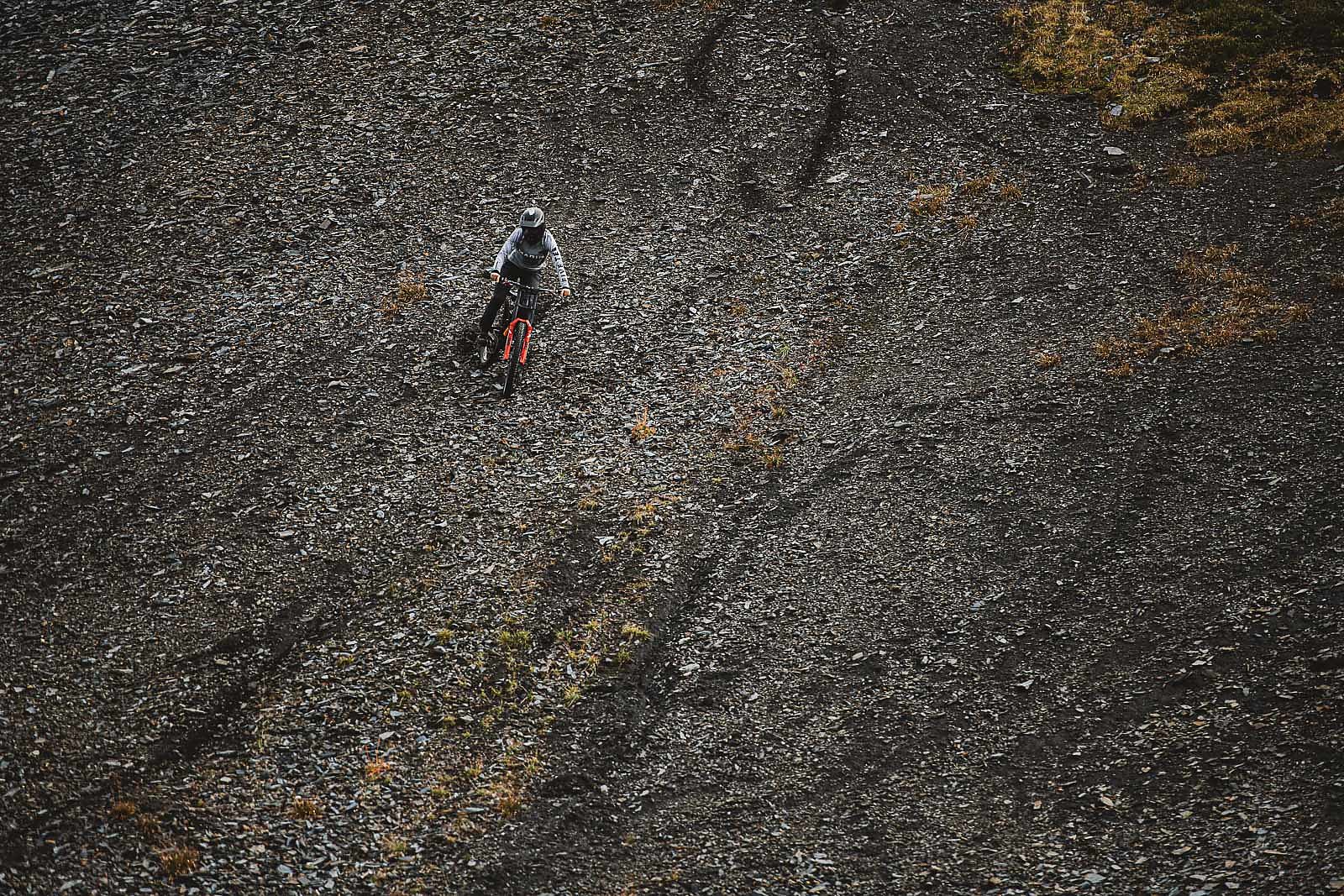
Between hauling buckets of dirt and swinging away with a mattock, Atli occasionally rips a shovel-guitar solo to the Led Zeppelin reverberating out of Rylan’s wireless speaker. When not altering the landscape themselves, they marvel at a century’s worth of destruction in the valley below and point out the names of peaks in the distance.
“You never really know what it’s going to look like—if it works, or not,” Rylan says. “But a lot of the time you just keep on truckin’ and it’ll pan out. We came up here, we looked at the mountain, we wandered around, and the terrain just kind of spoke for itself. It had a line. We just had to put it there.”
"We came up here, we looked at the mountain, we wandered around, and the terrain just kind of spoke for itself. It had a line. We just had to put it there.”—Rylan Bokstrom
The next day, it’s time to put the creation to the test. First attempts are always a little nerve-wracking, but if Vanderham is feeling anything, he isn’t showing it. The consummate professional, he knows what he wants and works methodically to achieve it. With wind howling over the ridgeline, it’s a waiting game. During a lull, Vanderham silently drops in, effortlessly navigating the scree slope, hauling into the bench cut and launching over the ridge. If the line rides half as well as he makes it look, it’s a success.
Just like the scree ridgeline, the sandy slope is new territory for Sandler. A cautious first attempt yields success, but not exactly elation. Back at the top, her hesitation is met with wise words from Vanderham: “If you’re not into it, don’t do it.” Hearing this articulated by someone with as much experience as Vanderham is a valuable lesson. Succumbing to pressure, even if it’s self imposed, is never worth the risk.
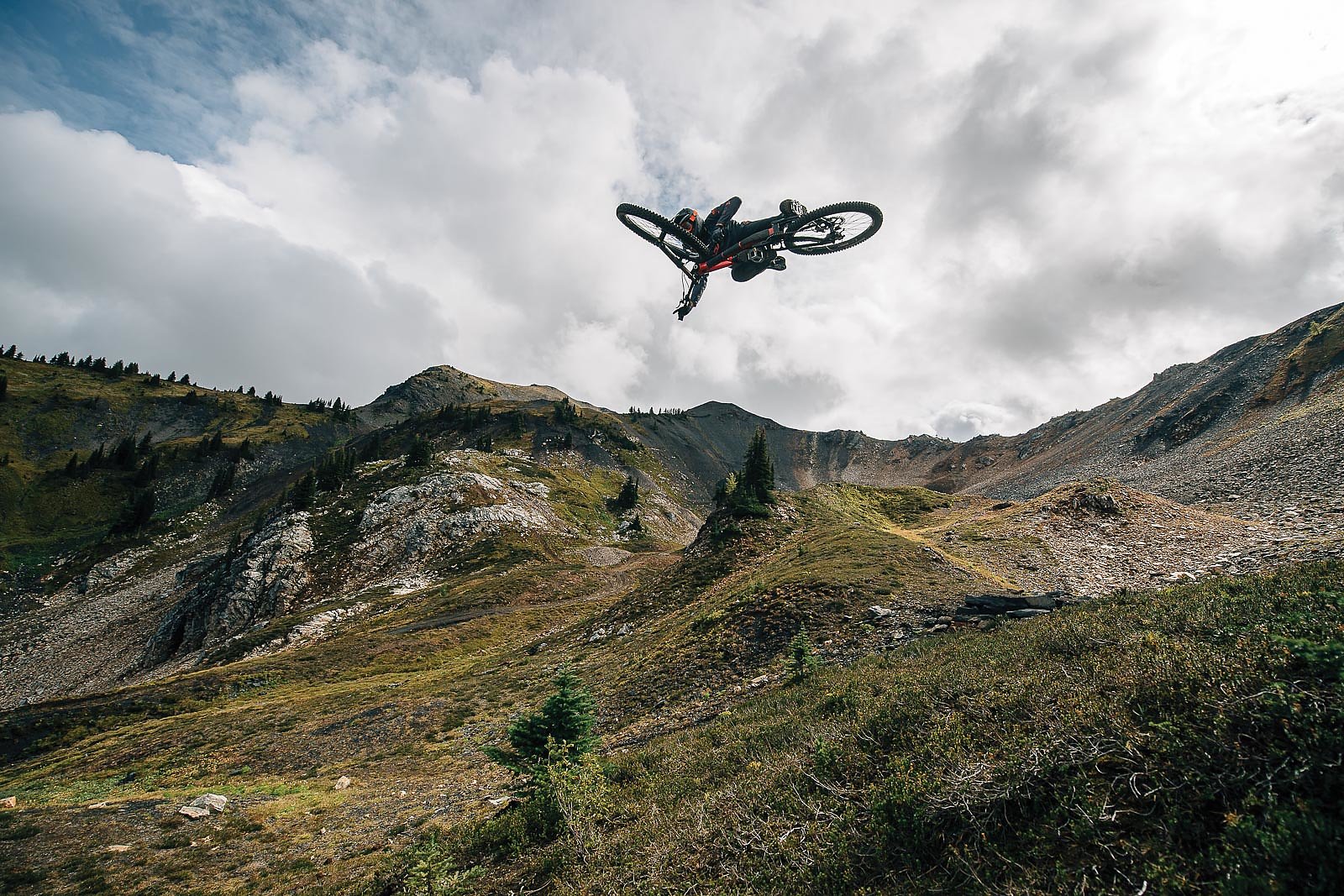
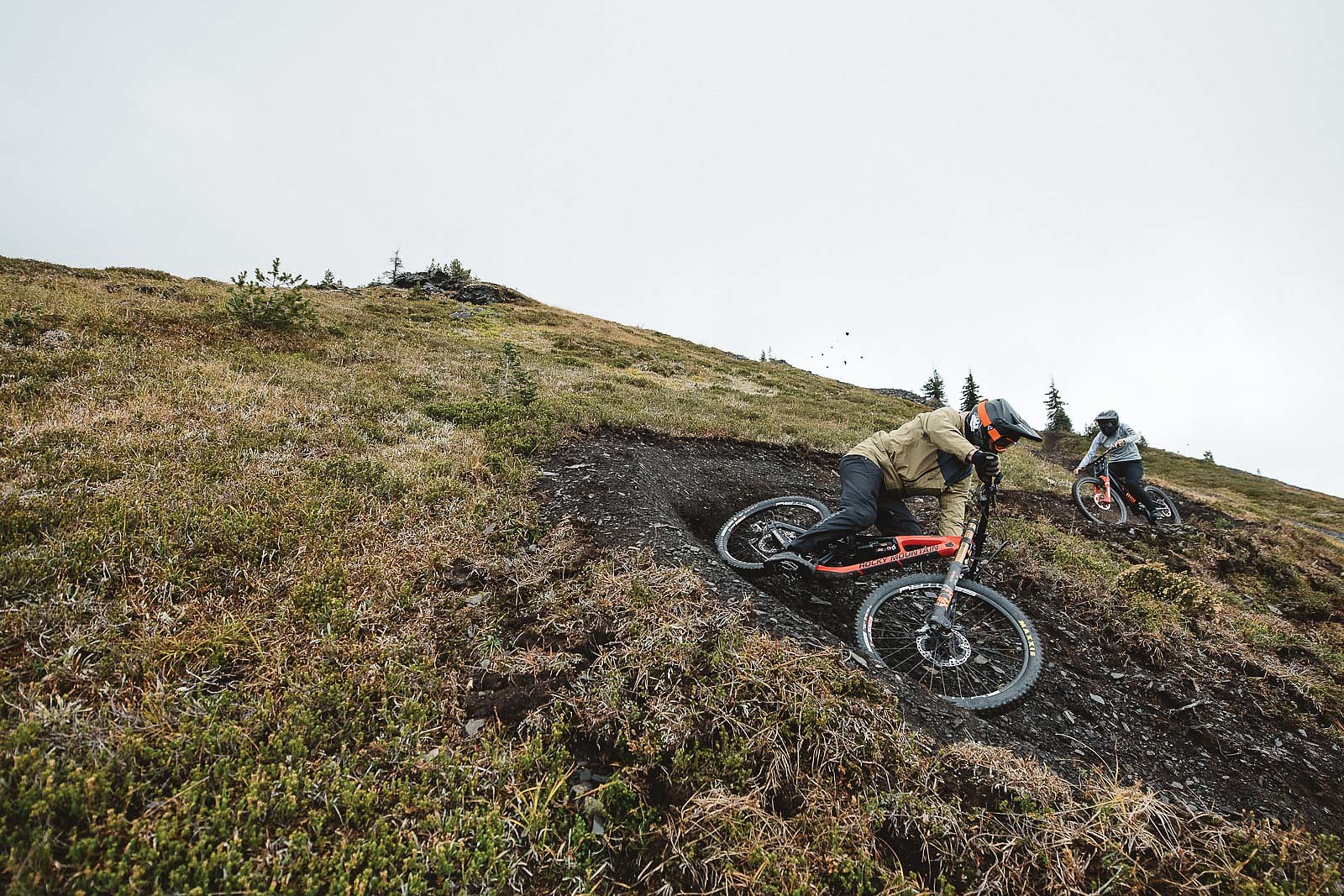

The pair continue onward and downward, soon arriving at the hip. They’ve already sent it a handful of times earlier in the morning, but it’s just too fun to hit once. Lap after lap, each hit becomes more graceful and lofty. Vanderham takes in a little more speed each time until he’s pushing the edge of the landing, while Sandler continues to perfect her midair style.
“I think it’s just a cool feeling to leave something behind—just to be part of a trail’s legacy from the beginning,” Vanderham says.
Legacies come in many forms. Sometimes, it’s a story passed down through generations. Other times, through a sight so beautiful it can’t be forgotten. Or, of course, a physical tribute that endures and reminds. In this moment, it’s all three. Every person who rides a bike through this basin will hear about the time that Thomas Vanderham and Veronique Sandler had a sunset session on this hip. The scene of them flying sky-high with the Kootenays in the distance, basking in blue evening light, will never be forgotten by anyone who was there. And the hip itself will long serve as evidence.
Vanderham, Sandler and the Bokstrom brothers might have been the ones leaving tire tracks and footprints here this week, but many more hands have made it all possible. From those filing paperwork in the office to the cooks in the kitchen, it’s been an ongoing project for many. This line through Antoine is much more than just a trail. It’s the embodiment of dedication, passion, persistence and joy—a sliver of hope in an otherwise forsaken valley.

